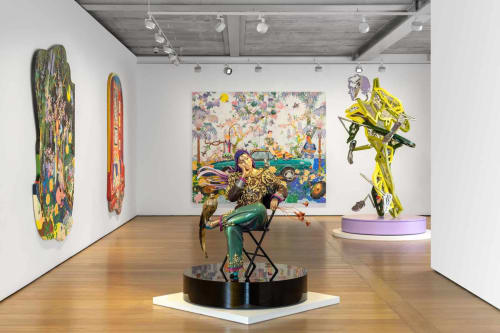![]()
Almine Rech has opened Episodes Far From Home, the gallery’s first exhibition of work by New York-based Japanese artist Tomokazu Matsuyama. The exhibition is on view until 20th May 2023 at Almine Rech London.
If you could read a pattern like a page in a book, the intricate textiles and wallpapers in Tomokazu Matsuyama’s paintings would speak volumes. Colorful motifs crowd the dense, graphical surfaces of his works, forming garden vistas or intimate boudoirs. Their origins are eclectic: a luscious floral might be drawn from a print by 19th-century British designer William Morris or from an Edo Period kimono. In a bed of plants from divergent climes, an empty Sapporo bottle and a Starburst wrapper lie like the detritus of globalization.
A portrait inspired by a photograph of French couturier Christian Dior, meanwhile, bears the golden flourishes of a counterfeit Hermes scarf that Matsuyama bought in New York’s garment district. Completed on dynamically shaped canvases, these paintings take their compositional cues from Grand Manner portraits or pastorals in the premodern European tradition, while their use of skewed perspectives and absence of shading recall the flat planes of Japanese woodblock prints known as ukiyo-e. Signifiers of East and West are willfully scrambled here, as are renditions of the ‘real’ and the ‘fake.’ In Matsuyama’s work, as with his own diasporic identity, such differences are shaky social constructions.
Matsuyama was born in Takayama, Japan and moved to New York in 2000 at age 25. In the Big Apple, he encountered the work of street artists like Keith Haring and enrolled at Pratt Institute to study graphic design. This may explain the graphic quality of his paintings – at least as much as the influence of the Japanese pictorial tradition. At the time, he had few venues to exhibit his self-taught work save the bare walls of industrial buildings along the Brooklyn waterfront, including in Greenpoint, where his studio remains today. The language of street art was stylistically formative, but it also shaped Matsuyama’s commitment to the public realm.
The 2000s were a time when Japanese art movements such as Simulationism and Superflat achieved global recognition, and Matsuyama was often confronted by the expectation that he deliver a recognizably anime-indebted style. Refusing to be reduced to cultural stereotypes, he chose instead to subvert them: the imagery in his work, then and now, filters influences from European and American art history through Japan and back again, so their origins can be difficult to pin down. Collaging elements from fashion and home décor magazines into compositions derived from the Western canon, he then adds layers of patterns from a wide range of sources – many of them drawn from his personal archive of historical textiles – that act as a kind of dazzle camouflage. Cloaked in these designs, his alluringly inexpressive figures withhold plenty of secrets.

